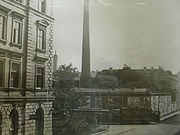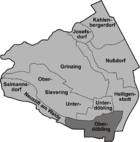
Oberdöbling
Encyclopedia
Oberdöbling was an independent municipality
until 1892 and is today a part of Döbling
, the 19th district of Vienna. It is also one of the 89 Katastralgemeinde
n.
and Unterdöbling
. In the east, the Barawitzkagasse and Heiligenstädter Straße mark the border with Heiligenstadt
, while the former Linienwall marks the border with Alsergrund
. In the south, Oberdöbling borders on Währing
and in the east on the section of the Katastralgemeinde
also known as Währing that lies in Döbling. A settlement named Hart used to stand on the site of modern-day Oberdöbling, but it was abandoned in the 14th century. Oberdöbling developed along what is now the Hofzeile.

. In 1689, six years after the attack, just 50 of 850 vineyards were in use. The settlement took a long time to recover. At the start of the 18th century for example, Oberdöbling was still somewhat smaller than neighbouring Unterdöbling. When the plague hit in 1713 though, the village fared better than others. Of its 31 houses, just 5 were infected; 13 people died. In 1721, Oberdöbling consisted of three rows of houses – the Hofzeile (today the upper right-hand side of the Döblinger Hauptstraße), the Kirchenzeile (today the left-hand side of the Hofzeile), and the Bachzeile by the Krottenbach (today the right-hand side of the Hofzeile). There were 39 houses in total. The emperor’s use of the surrounding land as hunting grounds made Oberdöbling attractive both for the nobility and for members of Vienna’s bourgeoisie. Those who could afford to do so built second residences here. As in Hietzing
, which profited from its proximity to the Schönbrunn Palace
, this phenomenon created the basis for Oberdöbling’s privileged development. Five new streets were built in the village between 1765 and 1786. Today, these are the Döblinger Hauptstraße, the Heiligenstädter Straße, the Pyrkergasse, the Pokornygasse and the Billrothstraße. Later, the village gained its own suburb, which covered the Gymnasiumstrasse, the Hardtgasse and the Pyrkergasse. This Neu-Döbling (New Döbling) area was characterised by the wealth of its inhabitants, whereas construction in Alt-Döbling (Old Döbling) was patchy. There were still many run-down huts in parts of the old village.
Around the middle of the 19th century, a construction boom began in Oberdöbling. In 1853, there were 323 houses with a total of 4229 inhabitants; in 1890, there were 14,460 inhabitants in 567 houses. In 1858, gas-powered street lighting was introduced. The gas was supplied by an English firm based in the area between the Gymnasiumstraße and the Billrothstraße from 1856. In 1892, Oberdöbling, along with the surrounding suburbs of Grinzing
, the Kahlenbergerdorf
, Nußdorf
, Heiligenstadt
, Sievering
and Josefsdorf
, was turned into the 19th district of Vienna, Döbling
.
 In contrast to the situation in the surrounding villages, viticulture
In contrast to the situation in the surrounding villages, viticulture
had already lost any significance in Oberdöbling’s economy at the start of the 19th century. Growing crops and fruit was already more profitable. Fields covered more than half of the available land; orchards took up a further 10 percent. In contrast, vineyards occupied approximately just seven percent of available land.
The first factory was built early in Oberdöbling. It was built in 1754, and produced velvet, silk, and fine fabrics. At first, it employed as many as 100 people; by 1790, there were already 300 people working in this factory. A hammer mill was built in 1783 at the point where the Arbesbach and the Krottenbach meet. The local brewery, which was founded to complement the brewery in Gaudenzdorf in 1833, and which was purchased by the owners of the Ottakringer Brauerei
in 1856, was well known. After the brewery was destroyed in World War II
, the Kopenhagenhof Gemeindebau
was built in its stead. Other important enterprises established in the 19th century included the Vereinigte Tintenfabriken Hartmann und Mittler, later known as the Kuli-Werk, which existed between 1867 and 1968 and stood at number 8 in the Gatterburggasse. Kattus, a producer of sparkling wine
, is today one of Döbling’s best-known enterprises.
Johanneskapelle on the corner of the Döblinger Hauptstraße and the Hofzeile. In 1859, the actors relocated to the theatre restaurant “Wendl” at Währinger Spitz, which boasted both a summer arena and an indoor theatre, after their original home was sold to the nuns Schwestern vom armen Kinde Jesu. Rude comedies were popular; plays by Johann Nestroy
were also produced. Alexander Girardi
and Max Reinhardt
both played here in their early years. The theatre was closed between 1881 and 1888 because of concerns over fire safety; in 1893 the entire restaurant folded.
Joseph Lanner and Johann Strauß the Elder
held concerts in the “Finger” casino in Oberdöbling, but the “Finger” had to close in 1840, probably because of competition from the nearby casino “Zögernitz” (Döblinger Hauptstraße 76). The “Zögernitz”, which had been opened in 1837, became one of the most popular casinos in Vienna. Strauß and Lanner also performed here. In the 1960s, the building was converted into a hotel with a restaurant.
Nowadays, Oberdöbling is home to the most important local museum, the Bezirksmuseum Döbling, which is housed in the Villa Wertheimstein.
. Besides the Döbling Parish Church
, Oberdöbling is also home to the nunnery of the Schwestern vom armen Kinde Jesu. This comprises educational institutions, a church and a chapel.
. Their gravestones were both preserved in the Strauß-Lanner-Park that was created on the site after 1927. Other famous persons buried in the Döblinger cemetery were Nikolaus Lenau
, Ludwig Boltzmann
and Johann Nepomuk Berger, whose remains were transferred to other cemeteries. The new Döblinger cemetery was created in Oberdöbling, on the border to Glanzing and Währing
. It is home to the graves of prominent local families such as Wertheimstein, Zacherl, Gräf and Kattus. Theodor Herzl
, Wilhelm Miklas
, Robert von Lieben
and Ferdinand von Saar
also found their last resting place here. Further to the south, on the border to Währing, there is also the last remnant of the Währinger cemetery, the abandoned Jewish cemetery.
Municipality
A municipality is essentially an urban administrative division having corporate status and usually powers of self-government. It can also be used to mean the governing body of a municipality. A municipality is a general-purpose administrative subdivision, as opposed to a special-purpose district...
until 1892 and is today a part of Döbling
Döbling
Döbling is the 19th District in the city of Vienna, Austria . It is located on the north end from the central districts, north of the districts Alsergrund and Währing...
, the 19th district of Vienna. It is also one of the 89 Katastralgemeinde
Katastralgemeinde
A Katastralgemeinde , a German word , is a cadastral subdivision of municipalities in the nations of Austria, Croatia, the Czech Republic, Slovakia, the Italian provinces of South Tyrol, Trentino, Gorizia, Trieste, and in Slovenia.A cadastral community records property ownership in a cadastre,...
n.
| Oberdöbling | |
|---|---|
| Coat of arms | Map |
 |
 |
Location: 48°14′28"N 16°21′18"E |
|
Geography
Oberdöbling lies in the south of the Döbling district of Vienna and covers an area of 241.20 hectares. In the north, Oberdöbling extends to the Krottenbach stream, thus bordering on SieveringSievering
Sievering is a suburb of Vienna and part of Döbling, the 19th district of Vienna. Sievering was created in 1892 out of the two erstwhile independent suburbs Untersievering and Obersievering. These still exist as Katastralgemeinden.- Geography :...
and Unterdöbling
Unterdöbling
Unterdöbling was an independent municipality until 1892 and is today a part of Döbling, the 19th district of Vienna. It is also one of the 89 Katastralgemeinden.- Geography :...
. In the east, the Barawitzkagasse and Heiligenstädter Straße mark the border with Heiligenstadt
Heiligenstadt, Vienna
Heiligenstadt was an independent municipality until 1892 and is today a part of Döbling, the 19th district of Vienna.Heiligenstadt is one of the 10 municipalities in the Döbling District.- Geography :...
, while the former Linienwall marks the border with Alsergrund
Alsergrund
Alsergrund is the ninth district of Vienna, Austria . It is located just north of the first, central district, Innere Stadt. Alsergrund was incorporated in 1862, with seven suburbs. The area is densely populated, with a lot of government-built housing. According to the census of 2001, there were...
. In the south, Oberdöbling borders on Währing
Währing
Währing is the 18th district of Vienna, Austria. It is in the northwest part of the city. In addition to currently hosting a number of Vienna's foreign embassies, Währing was the site of the original burial places of composers Ludwig van Beethoven and Franz Schubert.-Location:Währing lies in the...
and in the east on the section of the Katastralgemeinde
Katastralgemeinde
A Katastralgemeinde , a German word , is a cadastral subdivision of municipalities in the nations of Austria, Croatia, the Czech Republic, Slovakia, the Italian provinces of South Tyrol, Trentino, Gorizia, Trieste, and in Slovenia.A cadastral community records property ownership in a cadastre,...
also known as Währing that lies in Döbling. A settlement named Hart used to stand on the site of modern-day Oberdöbling, but it was abandoned in the 14th century. Oberdöbling developed along what is now the Hofzeile.
History

The origin of the name Döbling
Döbling is mentioned for the first time in an official document in 1114 as de Teopilic. This name is of Slavic origin; toplica either means “marshy water” and refers to the settlement’s location by the Krottenbach or derives from the Old Slavic term for a “warm creek”. Later usage includes spellings such as Toblich, Töbling and Tepling.The creation of Unterdöbling and Oberdöbling
Döbling’s first residents were almost exclusively farmers, who were largely reliant on their own produce. They produced wine for sale, but also planted cereals for this purpose and produced fruit, vegetables and milk products. In the 12th century, the nobles derer von Topolic owned Döbling, later it was the property of the Dominican monastery in Tulln. It is mentioned in a document from 1310 as the village of the ladies of Tulln. As time progressed, separate villages evolved, divided from one another by the Krottenbach. Unterdöbling was originally known as Chrottendorf; the name Unterdöbling is believed not to have been in use until the 15th century. The separation of the two settlements was recorded in an official document for the first time in 1591.Oberdöbling in the 17th and 18th centuries
A village seal dating from 1694 has been preserved. It depicts Saint James with the inscription Sigil der gemain Ober Döbling 1694 (Seal of the municipality Ober Döbling 1694). The village’s growth was arrested by the second siege of ViennaBattle of Vienna
The Battle of Vienna took place on 11 and 12 September 1683 after Vienna had been besieged by the Ottoman Empire for two months...
. In 1689, six years after the attack, just 50 of 850 vineyards were in use. The settlement took a long time to recover. At the start of the 18th century for example, Oberdöbling was still somewhat smaller than neighbouring Unterdöbling. When the plague hit in 1713 though, the village fared better than others. Of its 31 houses, just 5 were infected; 13 people died. In 1721, Oberdöbling consisted of three rows of houses – the Hofzeile (today the upper right-hand side of the Döblinger Hauptstraße), the Kirchenzeile (today the left-hand side of the Hofzeile), and the Bachzeile by the Krottenbach (today the right-hand side of the Hofzeile). There were 39 houses in total. The emperor’s use of the surrounding land as hunting grounds made Oberdöbling attractive both for the nobility and for members of Vienna’s bourgeoisie. Those who could afford to do so built second residences here. As in Hietzing
Hietzing
Hietzing is the 13th municipal District of Vienna . It is located west of the central districts, west of Meidling...
, which profited from its proximity to the Schönbrunn Palace
Schönbrunn Palace
Schönbrunn Palace is a former imperial 1,441-room Rococo summer residence in Vienna, Austria. One of the most important cultural monuments in the country, since the 1960s it has been one of the major tourist attractions in Vienna...
, this phenomenon created the basis for Oberdöbling’s privileged development. Five new streets were built in the village between 1765 and 1786. Today, these are the Döblinger Hauptstraße, the Heiligenstädter Straße, the Pyrkergasse, the Pokornygasse and the Billrothstraße. Later, the village gained its own suburb, which covered the Gymnasiumstrasse, the Hardtgasse and the Pyrkergasse. This Neu-Döbling (New Döbling) area was characterised by the wealth of its inhabitants, whereas construction in Alt-Döbling (Old Döbling) was patchy. There were still many run-down huts in parts of the old village.
Oberdöbling until its integration into the city of Vienna in 1892
At the end of the 18th century, Oberdöbling grew rapidly. In 1780, there were 136 houses with a total of 932 inhabitants. Growth then slowed however, so that the number of houses only increased from 188 to 202 with a total of 1550 inhabitants between 1822 and 1835. The last lord of Oberdöbling was Anton Edler von Wirth, who had bought the land from the authorities responsible for administrating state property in 1824. He was also lord of Sievering.Around the middle of the 19th century, a construction boom began in Oberdöbling. In 1853, there were 323 houses with a total of 4229 inhabitants; in 1890, there were 14,460 inhabitants in 567 houses. In 1858, gas-powered street lighting was introduced. The gas was supplied by an English firm based in the area between the Gymnasiumstraße and the Billrothstraße from 1856. In 1892, Oberdöbling, along with the surrounding suburbs of Grinzing
Grinzing
Grinzing was an independent municipality until 1892 and is today a part of Döbling, the 19th district of Vienna.- Geography :- Location :...
, the Kahlenbergerdorf
Kahlenbergerdorf
Kahlenbergerdorf was an independent municipality until 1892 and is today a part of Döbling, the 19th district of Vienna. It is also one of the 89 Katastralgemeinden.- Location :...
, Nußdorf
Nußdorf, Vienna
Nußdorf was a separate municipality until 1892 and is today a suburb of Vienna in the 19th district of Döbling.- Location :Nußdorf lies on both banks of the Nußbach , where the brook meets the Danube Canal...
, Heiligenstadt
Heiligenstadt, Vienna
Heiligenstadt was an independent municipality until 1892 and is today a part of Döbling, the 19th district of Vienna.Heiligenstadt is one of the 10 municipalities in the Döbling District.- Geography :...
, Sievering
Sievering
Sievering is a suburb of Vienna and part of Döbling, the 19th district of Vienna. Sievering was created in 1892 out of the two erstwhile independent suburbs Untersievering and Obersievering. These still exist as Katastralgemeinden.- Geography :...
and Josefsdorf
Josefsdorf
Josefsdorf was an independent municipality until 1892 and is today a part of Döbling, the 19th district of Vienna. It is also one of the 89 Katastralgemeinden.- Geography :...
, was turned into the 19th district of Vienna, Döbling
Döbling
Döbling is the 19th District in the city of Vienna, Austria . It is located on the north end from the central districts, north of the districts Alsergrund and Währing...
.
Economy

Viticulture
Viticulture is the science, production and study of grapes which deals with the series of events that occur in the vineyard. When the grapes are used for winemaking, it is also known as viniculture...
had already lost any significance in Oberdöbling’s economy at the start of the 19th century. Growing crops and fruit was already more profitable. Fields covered more than half of the available land; orchards took up a further 10 percent. In contrast, vineyards occupied approximately just seven percent of available land.
The first factory was built early in Oberdöbling. It was built in 1754, and produced velvet, silk, and fine fabrics. At first, it employed as many as 100 people; by 1790, there were already 300 people working in this factory. A hammer mill was built in 1783 at the point where the Arbesbach and the Krottenbach meet. The local brewery, which was founded to complement the brewery in Gaudenzdorf in 1833, and which was purchased by the owners of the Ottakringer Brauerei
Brauerei Ottakringer
The Ottakringer Brauerei is the last large brewery remaining in Vienna, Austria and is located in Ottakring, the 16th district of Vienna.- History :...
in 1856, was well known. After the brewery was destroyed in World War II
World War II
World War II, or the Second World War , was a global conflict lasting from 1939 to 1945, involving most of the world's nations—including all of the great powers—eventually forming two opposing military alliances: the Allies and the Axis...
, the Kopenhagenhof Gemeindebau
Gemeindebau
Gemeindebau is a German word for "municipality building". It refers to residential buildings erected by a municipality, usually to provide low-cost public housing....
was built in its stead. Other important enterprises established in the 19th century included the Vereinigte Tintenfabriken Hartmann und Mittler, later known as the Kuli-Werk, which existed between 1867 and 1968 and stood at number 8 in the Gatterburggasse. Kattus, a producer of sparkling wine
Sparkling wine
Sparkling wine is a wine with significant levels of carbon dioxide in it making it fizzy. The carbon dioxide may result from natural fermentation, either in a bottle, as with the méthode champenoise, in a large tank designed to withstand the pressures involved , or as a result of carbon dioxide...
, is today one of Döbling’s best-known enterprises.
Culture
Oberdöbling’s first theatre opened in 1835 in the desacralisedDesecration
Desecration is the act of depriving something of its sacred character, or the disrespectful or contemptuous treatment of that which is held to be sacred or holy by a group or individual.-Detail:...
Johanneskapelle on the corner of the Döblinger Hauptstraße and the Hofzeile. In 1859, the actors relocated to the theatre restaurant “Wendl” at Währinger Spitz, which boasted both a summer arena and an indoor theatre, after their original home was sold to the nuns Schwestern vom armen Kinde Jesu. Rude comedies were popular; plays by Johann Nestroy
Johann Nestroy
Johann Nepomuk Eduard Ambrosius Nestroy was a singer, actor and playwright in the popular Austrian tradition of the Biedermeier period and its immediate aftermath...
were also produced. Alexander Girardi
Alexander Girardi
Alexander Girardi was an Austrian] actor and tenor singer in operettas.- Career :Girardi was born in Graz; his father was the locksmith Andreas Girardi who had migrated to Graz from Cortina d'Ampezzo. Following the early death of his father, Alexander Girardi was raised by his stepfather who put...
and Max Reinhardt
Max Reinhardt
----Max Reinhardt was an Austrian theater and film director and actor.-Biography:...
both played here in their early years. The theatre was closed between 1881 and 1888 because of concerns over fire safety; in 1893 the entire restaurant folded.
Joseph Lanner and Johann Strauß the Elder
Johann Strauss I
Johann Strauss I , born in Vienna, was an Austrian Romantic composer famous for his waltzes, and for popularizing them alongside Joseph Lanner, thereby setting the foundations for his sons to carry on his musical dynasty...
held concerts in the “Finger” casino in Oberdöbling, but the “Finger” had to close in 1840, probably because of competition from the nearby casino “Zögernitz” (Döblinger Hauptstraße 76). The “Zögernitz”, which had been opened in 1837, became one of the most popular casinos in Vienna. Strauß and Lanner also performed here. In the 1960s, the building was converted into a hotel with a restaurant.
Nowadays, Oberdöbling is home to the most important local museum, the Bezirksmuseum Döbling, which is housed in the Villa Wertheimstein.
History
A church is mentioned in Döbling for the first time in 1267, but the oldest still-standing church can only be traced back to the 15th century.Church buildings
Oberdöbling falls within the Döbling parish, which belongs in turn to the 19th Vienna DeaneryDeanery
A Deanery is an ecclesiastical entity in both the Roman Catholic Church and the Church of England. A deanery is either the jurisdiction or residence of a Dean.- Catholic usage :...
. Besides the Döbling Parish Church
Döbling Parish Church
The Döbling Parish Church is a Roman Catholic parish church in the suburb of Oberdöbling in the 19th district of Vienna, Döbling.- History :...
, Oberdöbling is also home to the nunnery of the Schwestern vom armen Kinde Jesu. This comprises educational institutions, a church and a chapel.
Cemeteries
The original Döblinger cemetery was in Unterdöbling. It was closed in 1927. It housed inter alia the graves of Johann Strauß the Elder and Joseph Lanner, whose remains were transferred to the city’s central cemeteryZentralfriedhof
The Zentralfriedhof is one of the largest cemeteries in the world, largest by number of interred in Europe and most famous cemetery among Vienna's nearly 50 cemeteries.-Name and location:...
. Their gravestones were both preserved in the Strauß-Lanner-Park that was created on the site after 1927. Other famous persons buried in the Döblinger cemetery were Nikolaus Lenau
Nikolaus Lenau
Nikolaus Lenau was the nom de plume of Nikolaus Franz Niembsch Edler von Strehlenau , was a German language Austrian poet.-Biography:...
, Ludwig Boltzmann
Ludwig Boltzmann
Ludwig Eduard Boltzmann was an Austrian physicist famous for his founding contributions in the fields of statistical mechanics and statistical thermodynamics...
and Johann Nepomuk Berger, whose remains were transferred to other cemeteries. The new Döblinger cemetery was created in Oberdöbling, on the border to Glanzing and Währing
Währing
Währing is the 18th district of Vienna, Austria. It is in the northwest part of the city. In addition to currently hosting a number of Vienna's foreign embassies, Währing was the site of the original burial places of composers Ludwig van Beethoven and Franz Schubert.-Location:Währing lies in the...
. It is home to the graves of prominent local families such as Wertheimstein, Zacherl, Gräf and Kattus. Theodor Herzl
Theodor Herzl
Theodor Herzl , born Benjamin Ze’ev Herzl was an Ashkenazi Jew Austro-Hungarian journalist and the father of modern political Zionism and in effect the State of Israel.-Early life:...
, Wilhelm Miklas
Wilhelm Miklas
Wilhelm Miklas was an Austrian politician who served as the third President of Austria, from 1928 until its annexation by Nazi Germany in the Anschluss 1938.-Early life:...
, Robert von Lieben
Robert von Lieben
Robert von Lieben was a notable Austrian physicist.Robert von Lieben was born to Leopold von Lieben and Anna von Lieben.-Education:...
and Ferdinand von Saar
Ferdinand von Saar
Ferdinand Ludwig Adam von Saar was an Austrian novelist, playwright and poet....
also found their last resting place here. Further to the south, on the border to Währing, there is also the last remnant of the Währinger cemetery, the abandoned Jewish cemetery.
Education
Almost all grammar schools in Döbling are to be found in Oberdöbling. The GRG 19 and the GRW 19 are located in the Billrothstraße, the grammar school and business school of the Schwestern vom Armen Kinde Jesu are in the Hofzeile, the federal technical college Wien 19 is in the Krottenbachstraße, while the GRW 19 and the BG 19 are in the Gymnasiumstraße.Famous citizens
- Alfred von Henikstein (1810–1882), the highest-ranking Jewish officer in Austrian history
- Wilhelm August Rieder (1796–1880), Austrian painter

